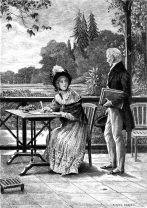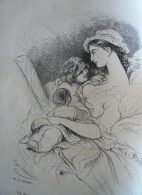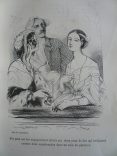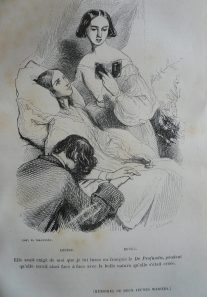
Letters of Two Brides
THE HUMAN COMEDY – Honoré de Balzac Second volume of works of Honoré de Balzac edited by widow André Houssiaux, publisher, Hebert and Co, successors, 7 rue Perronet – Paris (1877) Scenes from private life 
MEMOIRS OF TWO YOUNG BRIDES
Analysis and history Mémoires de deux jeunes mariées is a novel published in two parts under two different titles: Mémoires d’une jeune femme (probably written in 1834) and Soeur Marie des Anges, in La Presse in 1841. It was subsequently published by Furne in 1842 as Scènes de la vie privée and dedicated to George Sand, whose strength of character certainly inspired the author of La Comédie Humaine. The final title doesn’t quite convey the power, and sometimes violence, of this not-quite-balanced novel. The first part presents the character of a woman totally contemporary with our times: capable of fighting against her own to escape family laws, capable of extreme passions, capable of anything to live according to her own ideas. She’s one of those human racecars that drives brilliantly through La Comédie Humaine. The second, softer part (Balzac liked to introduce amiable characters, as George Sand wrote in 1856. ) portrays a young girl resigned to the desires of her family and society. Married by reason, she follows a smooth path and makes her family happy. It’s not really clear whether she’s a role model for female readers. But we can be pretty sure that Balzac prefers the woman of character.
The story Memoirs of Two Young Brides is another, more serious meditation on marriage, no longer addressed to young girls or parents, but to all women. Les mémoires de deux jeunes mariées is an epistolary novel based on an exchange of letters between two young women, from which a comparison of their destinies emerges. Louise de Chaulieu, from a very large family, is an aristocratic blonde, the famous blonde hair of the Franks, ardent, romantic, who plays all her life on a great love. Her friend from boarding school, Renée de Maucombe, is a kindly brunette from a more modest family, who is relegated by life to a quiet destiny: she has a somewhat effete, ugly husband, children . She tries to be happy in a Provençal bastide far from the glitz, the parties and the passions. The course of the novel makes the thesis very clear. Louise de Chaulieu realizes her dream of true love. She’s having a romantic wedding. She marries an illustrious outlaw, she has a lion at her feet, she reigns. This splendid love ends in disaster, with the husband dying of his furious love, suffocated in the grip of this capricious child-wife. After four years of despair, Louise de Chaulieu had another passion. She marries a great writer, a sensitive effeminate, the opposite of the first. And this second love, as passionate as the first, is also the opposite of her previous love. She no longer wants to be the queen, but the slave of the man (younger than herself) she loves. She locks him up in a gilded cage (jealous that he might prefer another), makes herself an odalisque for him and plays on this perfection of sensual love all her life. A misunderstanding leads her to believe that she is being deceived. His romantic soul is shattered by this disappointment, and the torments of doubt set in. She’s dying. Symbol of the lover, both queen and willing slave: two destructive images.

Renée
Renée de Maucombe, the countertype of this life, loyally accepted the destiny of wife that fate had bestowed upon her. She had children, she understood the greatness of this animal function that nature had entrusted to her. (Renée is more mother than wife). She made herself at home in Provence. She ends up with a deep affection for the friend that marriage has given her. Her husband, serious, calm and respectful, has had a slow but ultimately brilliant career. He will become an ambassador. The dialogue between the two friends brings out the thesis that these two contrasting lives highlight: “Friendship is the secret of married life”, says Renée. Two spouses shouldn’t be two lovers. This situation is contrary to the spirit of marriage, to the natural purposes of marriage, and to the balance of the family. Love in marriage is an accident on which it is impossible to base the law that must govern everything. “Louise de Chaulieu’s great romantic love is “a fault against the laws of social life”, just like Father Goriot’s excessive paternal love. And this disordered love is punished in the same way as the father’s disordered affection, by misfortune. Louise de Chaulieu wanted to make her dreams come true, first as a young girl, then as a woman: she lived in illusion, in an unreal idealism – these things have to be paid for, all unrealism has to be paid for. She consumes her life and dies.

Louise
The wise Renée de Maucombe is happy in the end, because she has understood that marriage can only be based on equal and calm sentiment, that he who bases his life on perpetual passion bases his life on excess of sentiment, perpetual excess in all things, and places within himself the source of imbalance and unhappiness. You are indulging,” she tells her friend, “in aberrations sanctioned by the law. And she ends with a word that sums it all up: “you are depraving the institution of marriage”. It’s not a novelist’s word, it’s a moralist’s word. Balzac’s entire novel contains a lesson in social morality. He is the doctor of a certain social health, and all the dramas he imagines are linked to the same theory of society.
Genealogy of characters

Louise Renée
Chaulieu: Noble family represented by Duke Henri, Ambassador born in 1773; wife Eléonore de Vaurémont, Hence : 1) Alphonse, Duke of Rhétoré, who married the Duchess of Argaïolo; 2) Armande Louise Marie born 1807, died 1835. Successively married Baron de Macumer and Marie Gaston; 3) the comte de Chaulieu, who married Madeleine de Mortsauf and thus became the duc de Lenoncourt-Chaulieu; 4) another Chaulieu, sister of Duke Henri, is a nun in Blois. Macumer: (baron de), Sardinian title taken by Duke Felipe de Soria. Exiled Spaniard died in 1829. Married Louise de Chaulieu in 1825. Gaston: Marie Gaston, a man of letters born around 1810, married Louise de Chaulieu, widow of Macumer, in 1833. Maucombe: Noble family from Provence represented by a Comte de Maucombe, hence : A son Jean, Renée married Louis de l’Estorade. L’Estorade: Noble Provencal family represented by a baron, then count, de l’Estorade and his wife, who died in 1826 and 1814, hence : One son Louis, born in 1787, deputy and peer of France; married Renée de Maucombe born in 1805, from whom : Armand-Louis, Jeanne-Athénaïs and René.
1) Sources analysis/history: 1) Wikipedia universal encyclopedia –
2) Preface compiled from the full text of the Comédie Humaine (tome I) published by France Loisirs 1986 under the auspices of the Société des Amis d’Honoré de Balzac.
2) Character genealogy source: Félicien Marceau “Balzac et son monde” Gallimard.
No Comments